Posted By admin on March 23, 2021

Left: Ruger New Vaquero in .357 Magnum with SASS cowboy action shooting specifications. Right: Ruger Wrangler in .22 Long Rifle (LR)
Ruger Wrangler, the Perfect Training Tool.
If you’re looking at this article, you are either a junior shooter, or you have been one at some point in the past. You have either been bitten by “the bug” of shooting sports just recently, or its DNA has settled in your bloodstream many decades ago. You are either someone in need of direction, or someone who has volunteered his or her time in the pursuit of helping others in the shooting sports world.
Recently I have come across a “tool” in the firearm’s industry that is so much fun; something that is equally fun, whether you are new to firearms or someone who has been around them a long time. Something that is well designed and engineered, reasonably priced, is an excellent training tool, and, most importantly, has a very high “fun factor”.
This is where the Ruger Wrangler comes in for those of us in the single action cowboy world. (See the Cerakote Wranglers in the pictures below) This particular firearm is by far the best training tool I have seen to date that mimics the feel and function of its big brother the Ruger Vaquero. (See the polished stainless steel Vaqueros below) Seldom does a “sister and clone” firearm come along that feels so much like the original that it makes perfect sense to own one. Of course a sister and clone is an almost exact replica of the original. It is something that allows you to work with it in such a way that you can develop your skills and at the same time, not put wear and tear on the original. Something that is less expensive to operate. Since the Ruger Vaquero is the single action revolver that I use and probably one of the most popular such handgun’s in our sport, it wasn’t until the release of the Ruger Wrangler in September of 2019 that the possibility of having such a practice tool even existed. Many reviews and YouTube videos’ have already been done about this .22 revolver, but nothing specific on this point as a training tool in the cowboy action world has been discussed.
Since I spend most of my time these days in the sport of cowboy action shooting, I am going to spend the majority of my time in this article with reference to that discipline. This of course is the world of

Left: New Vaquero, SASS Right: Wrangler The rear sights are very similar as are the hammers. The hammer on the New Vaquero is slightly wider.
SASS. (Single Action Shooting Society). This is the world that most, if not all of you were actually exposed to in the beginning of your firearm training. Not exactly the entire sport of cowboy action, but rather the tactile learning to operate a single-action firearm. This is the kind of firearm that requires the operator to manually manipulate the firearm to load one cartridge at a time. The feeding of that firearm could have been from a rotating cylinder, a tube magazine, a rotary magazine, or a cartridge holder like a belt or pouch on your person or nearby. It could have been a bolt action rifle, a break-action shotgun or in this case, a single-action revolver.
Firearm manipulation, the ability to develop muscle memory about which a particular firearm works in your hands takes a ton of practice. It takes dedication, persistence, patience, repetition, and a mature mind-set. It is not something that can happen over a short period of time. It is not something that can happen during a single season. It is something that can only be accomplished with hundreds if not thousands of hours. Something that needs to be practiced in all types of lighting and weather conditions, and then just when you think you have mastered it, something new occurs and you realize that even more effort is required. Not to mention that it is a skill that is “perishable” and must be revisited and practiced regularly to maintain a high degree of proficiency.
In the world of cowboy action, the revolver is always loaded with five rounds, not the six that there is room for in the cylinder. This is how the revolver was carried during the 1800’s. As a result, that is how we load it in our sport. This is the beginning of the manipulation of the firearm. Loading it in such a way that there is no live cartridge under the hammer before it is placed into a holster. In addition, our sport requires that you carry and manipulate two revolvers during a course of fire, also known as a stage. So as a result, just to begin with, being proficient with these single action revolvers requires the operator to load two handguns properly, and then holster them properly.
Because the Ruger Wrangler is essentially the same size as the Ruger Vaquero, (See photos) the fit and feel of it in your hand is going to be very close to the Ruger Vaquero. Of course the Wrangler is a .22 Cal long rifle cartridge firearm and the Vaquero is a .38 Cal. Cartridge firearm. This is where the financial savings is seen. The Wrangler is priced at less than half of

A pair of Wranglers in front and a pair of New Vaqueros in back.
what a Vaquero is priced at. Typically the Wrangler can be purchased at around the $200.00 dollar price point. And since in the cowboy world, you will need two of them, that price point is perfect for a firearm training tool. Not to mention the obvious savings on the cost of the ammunition.
Something else to think about, in the world of cowboy action, depending on the style you choose; traditional (One handgun at a time fired with both hands), duelist (one handgun fired with one hand one gun at a time), double duelist (one handgun fired one at a time, using each hand) or lastly, gunfighter (both hand’s firing both handguns simultaneously) transitioning in and out of the holsters is done on the clock. That means that your ability to move efficiently during these movements actually has more to do with being fast then pulling a trigger.
The Ruger Wrangler works perfect for “dry fire” and transition training. This is something the cowboy’s do a lot, not only “off season” but before matches. Because the physical dimensions of the Wrangler are so close to the Vaquero, replicating the draw stroke, (removing the handgun from the holster) is essentially the same. With the center of gravity, grip frame size, and barrel length nearly identical, the practice with the Wrangler almost completely replicates the Vaquero. This of course is as true on the return or holstering the Wrangler.
Even the reach for the hammer with the opposing thumb is nearly the same. In the photos, you will see that the “race guns” (Polished stainless steel SASS Vaqueros) with slightly lower and wider hammers, set up to SASS specifications are a very close match. Although you cannot see the trigger reach and travel, I will tell you that in my opinion, they are not so far off that it makes a huge difference under the stress of cowboy action shooting.
Also, in our sport there are many side matches. One “side match” in particular involves the use of a .22 caliber single-action revolver. It is called the 22 speed pistol event. This is typically a single gun, five round event. The shooter starts with the gun in hand and the barrel resting on a table top while in a standing position. On the clock, the shooter shoots at one or more steel targets as fast as possible. Five rounds fired in about two seconds is not unheard of. Once again the Wrangler is the perfect tool for this event.

Johnny Patriot and daughter Blue Fire
Although I have not talked to the design engineers at Ruger, I wouldn’t be surprised if someone along the way said this would be a perfect training tool for the Vaquero owners out there. It is my opinion that there isn’t a better sister and close to the Vaquero than the Wrangler. I think that if you have the opportunity to get behind one of these revolvers, you will be of the same opinion. It is the perfect beginning pistol for the Buckaroo or Buckerette in your world, and the Buckaroo or Buckerette inside all of us.
Happy Shooting,
Johnny Patriot, SASS #97665
V.P. Oregon Trail Rough Riders
Idahocowboyaction.org
////////////////
CHECK OUT JUNIOR SHOOTERS magazine’s INSTAGRAM PAGE! QR CODE BELOW
Lots of great posts by junior shooters! See what they are talking about.

Category: Action Pistol, Cowboy Action Shooting, Pistol / Revolver, Plinking Fun, SASS, SASS, Uncategorized |
No Comments »
Tags: blue fire, carly thompson, civilian marksmanship program, cmp, competitive shooting, competitive shooting programs, Foundation, Johnny Patriot, jr shooter, jr shooters, junior, junior camps, junior shooter, junior shooters, junior shooting camps, junior writers, juniors, kids, learn to shoot, learning to shoot, new vaquaero, Olympics, pistol, plinking, revolver, Ruger, ruger wrangler, SASP, Scholastic Action Shooting Program junior shooter, scholastic clay target program, sctp, shooting, shooting sports, SSSF, usa shooting, vaquero, wrangler, youth shooting, youth shooting sports






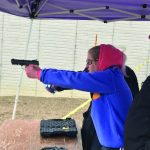

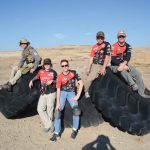
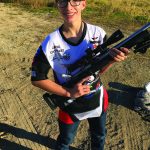


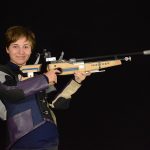
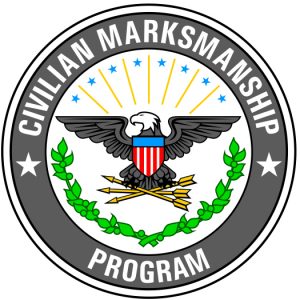
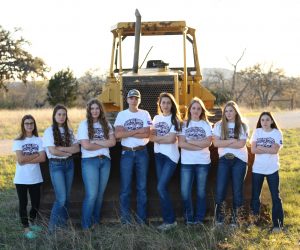









 We were 175 yards apart, and I was confident that I could make the shot. I waited for the buck to turn broadside to me, and that seemed to take forever, but that is part of the process. Then he finally moved to where I could make the shot and I got my breathing level, took my time to aim right, and pulled the trigger. I saw his head jump up and I thought I had missed again, Rick insisted that I had not. The buck took ten steps and was down.
We were 175 yards apart, and I was confident that I could make the shot. I waited for the buck to turn broadside to me, and that seemed to take forever, but that is part of the process. Then he finally moved to where I could make the shot and I got my breathing level, took my time to aim right, and pulled the trigger. I saw his head jump up and I thought I had missed again, Rick insisted that I had not. The buck took ten steps and was down. After we were home for a few days, I was able to take the head to Swanson Skullery in Emmett, ID to have the euro mount done. They have a deal were any junior can bring in their first big game harvest and Swanson’s will do the cleaning process for free. A few weeks later, I got the finished product back, and it was perfect. It took a long time and a lot of help from others for me to get my first big game harvest. I am grateful to all of them for the effort they put in to help me out. It was a great experience and I cannot wait to do it again.
After we were home for a few days, I was able to take the head to Swanson Skullery in Emmett, ID to have the euro mount done. They have a deal were any junior can bring in their first big game harvest and Swanson’s will do the cleaning process for free. A few weeks later, I got the finished product back, and it was perfect. It took a long time and a lot of help from others for me to get my first big game harvest. I am grateful to all of them for the effort they put in to help me out. It was a great experience and I cannot wait to do it again.
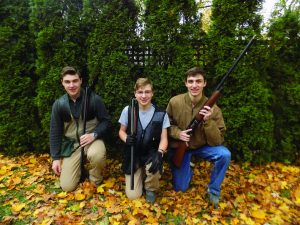 Anthony, Dominic and Vincent Basile are three brothers from Rochester New York who share a passion for clay target sports. Two years ago, they were shooting on the Hunters Tour sporting clays league when shotgun coach Bob Broderick approached the boys and their father and asked if they might be interested in joining a Scholastic Clay Target team. At the time the A&B Clay Busters consisted of one athlete and one coach. Their response was an immediate “yes”, and the Clay Busters could now legitimately call themselves a team. The boy’s enthusiasm was contagious, and they spread word at their local club how great the program was. The team has since grown to 10 athletes with the expectation to grow even larger.
Anthony, Dominic and Vincent Basile are three brothers from Rochester New York who share a passion for clay target sports. Two years ago, they were shooting on the Hunters Tour sporting clays league when shotgun coach Bob Broderick approached the boys and their father and asked if they might be interested in joining a Scholastic Clay Target team. At the time the A&B Clay Busters consisted of one athlete and one coach. Their response was an immediate “yes”, and the Clay Busters could now legitimately call themselves a team. The boy’s enthusiasm was contagious, and they spread word at their local club how great the program was. The team has since grown to 10 athletes with the expectation to grow even larger.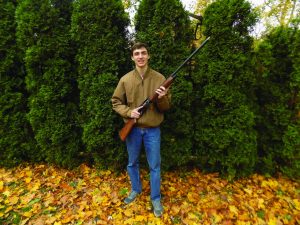 Anthony Basile has gotten quite a lot out of the Scholastic Clay Target Program over the past two seasons. “I have learned how to operate on a team and how to learn from my mistakes,” says Anthony. He hopes this year to improve his focus and confidence throughout an event, specifically sporting clays. Anthony in the past has taken first place for trap in the SCTP state championships and hopes for many more wins in the future. When Anthony isn’t shooting you can find him doing computer programming, robotics or working on 3d design. Following high school Anthony plans to attend college and pursue a career in 3d design and animation.
Anthony Basile has gotten quite a lot out of the Scholastic Clay Target Program over the past two seasons. “I have learned how to operate on a team and how to learn from my mistakes,” says Anthony. He hopes this year to improve his focus and confidence throughout an event, specifically sporting clays. Anthony in the past has taken first place for trap in the SCTP state championships and hopes for many more wins in the future. When Anthony isn’t shooting you can find him doing computer programming, robotics or working on 3d design. Following high school Anthony plans to attend college and pursue a career in 3d design and animation. Dominic started shooting at the age of 12 along with Anthony. “When I broke my first target, I instantly became addicted to the sport,” says Dominic. When asked what he thought the toughest part about shooting was for him, he said “staying consistent was the hardest, as well as treating every opportunity to shoot as an opportunity to learn”. These are key components that Dominic has chosen to focus and improve on this Scholastic season. In addition to shooting Dominic has a passion for physical fitness and health and hopes to take this passion into the medical field later in life.
Dominic started shooting at the age of 12 along with Anthony. “When I broke my first target, I instantly became addicted to the sport,” says Dominic. When asked what he thought the toughest part about shooting was for him, he said “staying consistent was the hardest, as well as treating every opportunity to shoot as an opportunity to learn”. These are key components that Dominic has chosen to focus and improve on this Scholastic season. In addition to shooting Dominic has a passion for physical fitness and health and hopes to take this passion into the medical field later in life. Vincent has been following in his older brothers’ footsteps and has progressed extremely well. The 14-year-old took first place in skeet, second place in sporting clays and third place in trap at last year’s Spring Competitions. His goals this year include developing a pre shot routine, meeting new people and going to the SCTP nationals in Ohio this year. When asked why he loves shooting so much his response was simple. “I can go out to an event or practice and meet lots of new kids” which is a key part of what SCTP is all about. When Vincent is not out practicing you can find him playing piano or enjoying a good book. He hopes to attend a music university to study piano performance.
Vincent has been following in his older brothers’ footsteps and has progressed extremely well. The 14-year-old took first place in skeet, second place in sporting clays and third place in trap at last year’s Spring Competitions. His goals this year include developing a pre shot routine, meeting new people and going to the SCTP nationals in Ohio this year. When asked why he loves shooting so much his response was simple. “I can go out to an event or practice and meet lots of new kids” which is a key part of what SCTP is all about. When Vincent is not out practicing you can find him playing piano or enjoying a good book. He hopes to attend a music university to study piano performance.

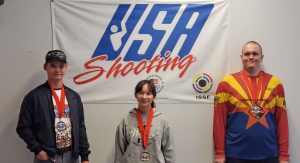

 When the athletes are on the firing line, coaching is not allowed, so coaches must properly prepare their athletes ahead of time with the full knowledge they are going to need during the match.
When the athletes are on the firing line, coaching is not allowed, so coaches must properly prepare their athletes ahead of time with the full knowledge they are going to need during the match.
 The Civilian Marksmanship Program (CMP) has announced the top performers of its Monthly Match League competition series for the 2020 season.
The Civilian Marksmanship Program (CMP) has announced the top performers of its Monthly Match League competition series for the 2020 season.


 The Beretta 92 was designed in 1972, but its popularity didn’t come to be until after 1985 when the United States military replaced the M1911A1 .45 ACP pistol with the Beretta M9, the Model 92, which is still in service today. The action is double-action/single-action with the first cartridge being fired in double-action mode unless the hammer is pulled back first. It is now available in several variations and calibers, but the M9 came in 9mm with a factory standard 15-round magazine. Chiappa’s M9 .22 LR is the spitting image of the U.S. military’s M9 9mm. It comes in .22 Long Rifle with a 10-round magazine and weighs in at 2.3 pounds. With a MSRP of $259, this gun is fun to shoot and very accurate.
The Beretta 92 was designed in 1972, but its popularity didn’t come to be until after 1985 when the United States military replaced the M1911A1 .45 ACP pistol with the Beretta M9, the Model 92, which is still in service today. The action is double-action/single-action with the first cartridge being fired in double-action mode unless the hammer is pulled back first. It is now available in several variations and calibers, but the M9 came in 9mm with a factory standard 15-round magazine. Chiappa’s M9 .22 LR is the spitting image of the U.S. military’s M9 9mm. It comes in .22 Long Rifle with a 10-round magazine and weighs in at 2.3 pounds. With a MSRP of $259, this gun is fun to shoot and very accurate.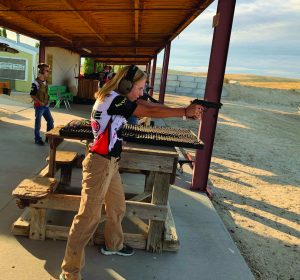 Here is what one of our juniors thought about it:
Here is what one of our juniors thought about it:




